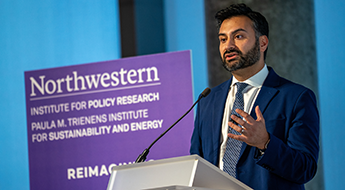Tackling a ‘Once in a Century Education Crisis’
How tutoring can turn the tide on pandemic learning losses
Get all our news
Change requires change. If we want to dramatically change how fast students learn, schools need to dramatically change schooling.”
Jonathan Guryan and Jens Ludwig
Co-Directors of the University of Chicago Education Lab

The federal funds allotted to school districts to combat pandemic-induced learning loss will end in less than a year, but the U.S. is stalled on progress to reverse the once-a-century education crisis.
Remote learning and chronic absenteeism between 2019 and 2022 led students to lose an average of three quarters of a year of schooling, and disadvantaged children, who experienced existing disparities the pandemic only exacerbated, fell even further behind.
In a new paper and an op-ed in the Hill, IPR economist Jonathan Guryan and University of Chicago economist Jens Ludwig seek to understand why such little progress has been made on overcoming the substantial learning losses for most of America’s K–12 students—and they propose solutions to move forward.
Compared to before the pandemic, students in most grades showed slower growth in math and reading, and most states reported troubling setbacks in math scores last year for almost all demographic groups. Because education is cumulative, Guryan and Ludwig, co-directors of the University of Chicago Education Lab, state that the losses could have permanent effects if not soon reversed. And if they are not, they may set a whole generation of students off track for the rest of their lives.
As educators grappled with the sudden switch to remote learning in March 2020, Congress sent $189.5 billion to schools through the Elementary and Secondary School Emergency Relief (ESSER) Fund through March 2021. While some of the funding was used to replace lost tax revenue, schools also had to set aside at least 20% for evidence-based interventions to address learning loss, such as tutoring.
“High-dosage” tutoring, an intervention both authors have studied previously, is proven to double, or even triple, the amount a student learns in a year. The individualized, intensive, and in-school tutoring intervention, which costs $3,500 to $4,300 per student per year, was developed by Saga Education, a nonprofit organization. In the program, a tutor works with two students at a time for a full class period every school day.
Many school districts have struggled to implement high-dosage tutoring in ways that are most effective. Some schools have provided tutoring after school or even virtually with students at home, but Guryan and Ludwig find this to be ineffective. Tutoring is the most effective when it’s integrated into the daily curriculum, the researchers find, but it’s difficult for schools to carve out the time during the day to devote to it, and they often lack the funding. The researchers find that high-dosage tutoring, or what they refer to as the closest thing we have to a “COVID learning loss” vaccine, is the most effective, but requires radical changes to the traditional school-day structure.
“Change requires change. If we want to dramatically change how fast students learn, schools need to dramatically change schooling,” Guryan and Ludwig wrote in the op-ed. “Unfortunately, the federal government gave school districts too little time, and too little money, to address the scale of the learning loss problem.”
To get students to participate, the researchers say tutoring must be done during the school day, and effective tutoring requires a structured curriculum to help students learn content they don’t know that’s below their current grade level. Schools also typically assume that successfully teaching children requires extensive prior experience and training, but Saga’s use of paraprofessionals instead of teachers is also effective and costs less, the researchers explain. They acknowledge that the changes needed to dramatically accelerate student learning are hard but must be done to avoid the alternative.
While the schools need to be willing to implement change, they also need the funds to make it possible. The authors call on Congress to extend funding and avoid “squandering the potential of an entire generation of 50 million students,” as well as possibly increasing economic inequality due to worse learning losses for students of color and those from lower-income households. Policymakers also should provide additional resources beyond the initial funding, and push schools to take those difficult steps.
“The failure to give schools more time and money would be the equivalent of calling it quits on overcoming pandemic learning loss,” Guryan and Ludwig wrote. “That would be like quitting a race just when you get to the starting line.”
Read the paper from the Aspen Strategy Consulting Group.
Jonathan Guryan is the Lawyer Taylor Professor of Education and Social Policy and an IPR fellow. Jens Ludwig is the Edwin A. and Betty L. Bergman Distinguished Service Professor at the University of Chicago. They are co-directors of the Education Lab.
Photo credit: iStock
Published: November 1, 2023.


